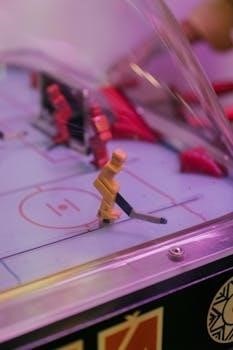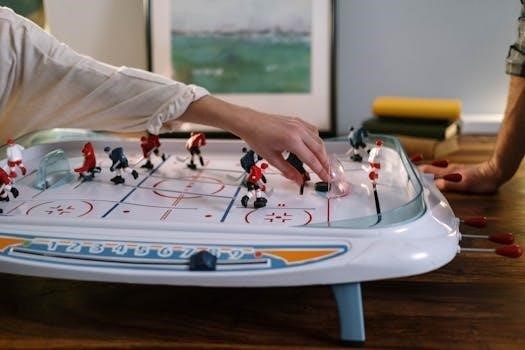Selecting the correct hockey stick size is crucial for optimal performance and comfort. A properly sized stick enhances puck control, shooting accuracy, and overall player development. This guide explores methods for determining the ideal stick length.
Importance of Proper Stick Length
Using a hockey stick that is the correct length significantly impacts a player’s ability to handle the puck effectively and maintain proper posture, directly influencing their technique and overall gameplay. A stick that is too long can hinder stickhandling and make it difficult to control the puck closely, leading to reduced agility and less precise passes and shots. Conversely, a stick that is too short can force a player to bend over excessively, causing back strain and limiting their reach and power. The right stick length allows a player to skate comfortably, maintain balance, and maximize their ability to maneuver the puck efficiently. It also enables better posture, reducing the risk of injury and promoting good habits. Ultimately, selecting the appropriate stick length is crucial for comfortable and effective play, facilitating the development of skills and allowing players to perform at their best.

Measuring for Hockey Stick Height
Accurately measuring for hockey stick height is essential for optimal performance. There are a couple of methods to determine the right length, which includes taking into account the player’s stance and height.
Standing Height Measurement
The standing height method is a straightforward way to estimate the correct hockey stick length. Have the player stand straight, without skates, on a flat surface. Then, place the hockey stick upright, with the blade touching the ground, alongside the player. The general guideline is that the top of the stick should reach somewhere between the player’s chin and nose. If the player is a beginner, it is often recommended that the stick reach the nose. This allows for better control and helps in learning the basics. As players progress, they may prefer a stick that is a bit shorter, usually reaching the chin. This can improve puck handling and quickness, but this may not be suitable for a beginner. This method is a quick estimation, and other factors should be considered for a perfect fit.
Torso-Based Measurement (Hip and Belly Button)
An alternative method to gauge proper hockey stick length involves the player’s torso. With the player standing upright, place the stick vertically in front of them. For adult players, a common recommendation is that the top of the stick should reach approximately to the top of the hip bone. This measurement is a good starting point for most players and offers a balance between reach and control. For younger players, especially children, the stick should be slightly higher, typically reaching the belly button. This allows for better control and handling as they learn the sport. This method is considered quite accurate and useful, but personal preference and playing style can also influence the ideal stick length. It is important to consider both measurements and individual needs.

Hockey Stick Size Charts
Hockey stick size charts are valuable tools for finding the right length based on age, height, and playing level. These charts provide recommended ranges for various player categories.
Age and Height-Based Recommendations
Age and height are primary factors when determining hockey stick length. Younger players require shorter sticks to facilitate puck handling and control. Typically, youth sticks range from 28 to 32 inches, while junior sticks fall between 32 and 35 inches. These lengths accommodate smaller frames and developing motor skills. As players grow taller, they transition to intermediate and then senior stick sizes, typically 35 to 37.5 inches. Height-based charts often provide specific recommendations, matching a player’s height to a range of suitable stick lengths. However, these are guidelines, and personal preference should be considered. For example, a player who is 5’8″ might start with a 36.5-inch stick, but might prefer a shorter or longer stick based on their feel and playing style. Remember that these are simply starting points.
Junior vs Senior Stick Lengths
The distinction between junior and senior hockey stick lengths is significant, reflecting the physical differences between age groups. Junior sticks are designed for younger players, typically those under 14, with lengths generally ranging from 32 to 35 inches. These sticks are shorter and often have a thinner shaft, making them easier for smaller hands to manage. Senior sticks, on the other hand, cater to players 14 and older, with lengths typically ranging from 35 to 37.5 inches and a thicker shaft. The longer length of senior sticks allows for a wider reach and more power when shooting and passing. The proper stick length for a developing player is crucial for skill development and comfort. Transitioning from a junior to a senior stick should be done when the player is physically able to handle the longer stick.

Factors Affecting Stick Length Choice
Several elements influence the ideal hockey stick length, including the player’s position and preferred playing style. Personal preference should also be considered when selecting a stick for optimal performance.
Playing Position (Forward vs Defender)
The role a player has on the team often dictates the preferred hockey stick length. Forwards generally benefit from a shorter stick, which enhances their puck handling abilities and quickens their movements. A shorter stick allows for tighter control in close quarters and faster dekes, which is essential for offensive plays. This provides better maneuverability and precision when navigating through opponents. Conversely, defenders often opt for a longer stick. A longer stick increases their reach, allowing for more effective poke checks and better interception of passes. The extra length also provides more power behind their slap shots, which are crucial for clearing the defensive zone. A longer stick aids in disrupting opponent’s plays and maintaining a robust defensive presence. These variations in stick length between forwards and defenders cater to the different demands and responsibilities of each position on the ice. Ultimately, selecting a stick based on a player’s role helps optimize their overall performance and effectiveness during gameplay.
Personal Preference and Playing Style
Beyond general guidelines and positional requirements, a player’s personal preference and individual playing style significantly influence the ideal hockey stick length. Some players simply feel more comfortable with a stick that is slightly shorter or longer than what might be recommended by standard charts. This comfort directly impacts their confidence and ability on the ice. A player’s unique approach to the game should also factor into the decision. For instance, players who favor speed and agility might prefer a shorter stick for quicker puck handling and maneuverability. Conversely, those who prioritize power and reach might find a longer stick more suitable for their slap shots and defensive plays. Ultimately, the most effective stick is one that feels natural and allows a player to execute their skills effectively. Experimenting with different lengths to identify what best complements their individual style and preferences is key to optimal gameplay. Finding the right stick is a very personal and can be a journey, where different sizes should be tested.

Additional Considerations
Beyond length, factors like stick flex, kick point, and weight also influence performance. These aspects work in tandem to ensure a stick complements the player’s physical attributes and playing style. Regulations also need to be considered.
Stick Flex and Kick Point
Stick flex, measured numerically, indicates how much a stick bends under pressure. A lower flex number signifies a softer stick, ideal for players seeking a quicker release and easier loading, while a higher flex number represents a stiffer stick, preferred by those who prefer more power. The kick point, where the stick bends most, also affects shot performance. A low kick point is great for quick snapshots, while a mid or high kick point is suitable for slap shots. Finding the right combination of flex and kick point depends on a player’s strength, shooting style, and personal preferences. Understanding these aspects allows for better energy transfer and overall puck control. Also, the flex rating can change when a stick is cut shorter.
Weight of the Hockey Stick
The weight of a hockey stick significantly impacts a player’s performance and handling ability. Lighter sticks, typically favored by forwards, allow for quicker stick movements and enhanced puck control. This is due to the reduced effort required for stick handling, passing, and shooting. Conversely, heavier sticks can generate more power in shots, often preferred by defensemen for clearing the puck and taking powerful slap shots. The weight distribution within the stick also plays a crucial role, affecting the balance and feel for the player. The typical weight for adult sticks ranges from 19 to 21 ounces, with a maximum regulation of 26 ounces. Selecting the ideal stick weight depends on a player’s strength, playing style, and personal preferences.
Hockey Stick Regulations (FIH)
The International Hockey Federation (FIH) sets specific regulations regarding hockey stick dimensions to ensure fair play and safety. These rules govern the maximum length and weight of sticks used in sanctioned matches. According to current FIH regulations, the maximum allowable length for a hockey stick is 41 inches (104.1cm). Additionally, the maximum weight of a stick is limited to 26 ounces (737g). The FIH also stipulates rules concerning the bow position and the upturn of the stick’s toe, which have changed over time. These regulations aim to maintain a level playing field and prevent any unfair advantages gained through modified equipment. Players must be aware of and adhere to these guidelines for compliance during gameplay.